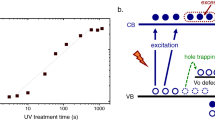Abstract
Hydrogenated In-doped ZnO (ZIO:H) films grown at different ratios, R, of hydrogen to argon were deposited at a substrate temperature of 100 °C for the organic light-emitting diodes (OLEDs). The OLEDs with the ZIO:H (R = 0.08) anode achieved a maximum luminance efficiency of 3.4 cd/A and a power efficiency of 0.6 lm/W, which are as good as the values of the control device fabricated on a tin-doped indium oxide (ITO) anode. This indicates that the efficiency of the OLEDs is critically affected by the ratio of injected hydrogen gas during the deposition of the ZIO and that the ZIO:H developed herein is promising as an alternative to conventional ITO.








Similar content being viewed by others
References
K. Kawano, N. Ito, T. Nishimori J. Sakai: Open circuit voltage of stacked bulk heterojunction organic solar cells. Appl. Phys. Lett. 88, 073514 2006
H. Kim, J.S. Horwitz, W.H. Kim, A.J. Makinen, Z.H. Kafafi D.B. Chrisey: Doped ZnO thin films as anode materials for organic light-emitting diodes. Thin Solid Films 420–421, 539 2002
H. Kim, J.S. Horwitz, G.P. Kushuto, S.B. Qadri, Z.H. Kafafi D.B. Chrisey: Transparent conducting Zr-doped In2O3 thin films for organic light-emitting diodes. Appl. Phys. Lett. 78, 1050 2001
Y. He J. Kanicki: High-efficiency organic polymer light-emitting heterostructure devices on flexible plastic substrates. Appl. Phys. Lett. 76, 661 2000
A. Yamamori, S. Hayashi, T. Koyama Y. Taniguchi: Transparent organic light-emitting diodes using metal acethylacetonate complexes as an electron injective buffer layer. Appl. Phys. Lett. 78, 3343 2001
S. Homma, A. Miyamoto, S. Sakamoto, K. Kishi, N. Motoi K. Yoshimura: Pulmonary fibrosis in an individual occupationally exposed to inhaled indium-tin oxide. Eur. Respir. J. 25, 200 2005
T. Homma, T. Ueno, K. Sekizawa, A. Tanaka M. Hirata: Interstitial pneumonia developed in a worker dealing with particles containing indium-tin oxide. J. Occup. Health 45, 137 2003
H. Kim, C.M. Gilmore, J.S. Horwitz, A. Pique, H. Murata, G.P. Kushto, R. Schlaf, Z.H. Kafafi D.B. Chrisey: Transparent conducting aluminum-doped zinc oxide thin films for organic light-emitting devices. Appl. Phys. Lett. 76, 259 2000
S.M. Park, T. Ikegami K. Ebilhara: Investigation of transparent conductive oxide Al-doped ZnO films produced by pulsed laser deposition. Jpn. J. Appl. Phys. 44, 8027 2005
X. Jiang, F.L. Wong, M.K. Fung S.T. Lee: Aluminum-doped zinc oxide films as transparent conductive electrode for organic light-emitting devices. Appl. Phys. Lett. 83, 1875 2003
H. Kim, J.S. Horwitz, W.H. Kim, S.B. Qadri Z.H. Kafafi: Anode material based on Zr-doped ZnO thin films for organic light-emitting diodes. Appl. Phys. Lett. 83, 3809 2003
J. Hu R.G. Gordon: Textured aluminum-doped zinc oxide thin films from atmospheric pressure chemical-vapor deposition. J. Appl. Phys. 71, 880 1992
J.H. Kang, Y.R. Park K.J. Kim: Spectroscopic ellipsometry study of Zn1–xMgxO thin films deposited on Al2O3(0001). Solid State Commun. 115, 127 2000
K.J. Kim Y.R. Park: Large and abrupt optical band gap variation in In-doped ZnO. Appl. Phys. Lett. 78, 475 2001
S.H. Jeong, B.N. Park, D.G. Yoo, J.H. Boo D.J. Jung: Al-ZnO Thin films as transparent conductive oxides: Synthesis, characterization, and application tests. Korean Phys. Soc. 50, 622 2007
S.B. Qadri, H. Kim, J.S. Horwitz D.B. Chrisey: Transparent conducting films of ZnO–ZrO2: Structure and properties. J. Appl. Phys. 88, 6564 2005
J.H. Kim, B.D. Ahn, C.H. Lee, K.A. Jeon, H.S. Kang S.Y. Lee: Effect of rapid thermal annealing on electrical and optical properties of Ga doped ZnO thin films prepared at room temperature. J. Appl. Phys. 100, 113515 2005
C.G. Van de Walle: Hydrogen as a cause of doping in zinc oxide. Phys. Rev. Lett. 85, 1012 2000
C.G. Van de Walle J. Neugebauer: Universal alignment of hydrogen levels in semiconductors, insulators and solutions. Nature 423, 626 2003
S.Y. Myong K.S. Lim: Highly stable and textured hydrogenated ZnO thin films. Appl. Phys. Lett. 82, 3206 2003
A. Janotti C.G. Van de Walle: Hydrogen multicentre bonds. Nat. Mater. 6, 44 2007
S.Y. Myong K.S. Lim: Alternate deposition and hydrogen doping technique for ZnO thin films. J. Cryst. Growth 293, 253 2006
E.V. Lavrov, J. Weber, F. Borrnert, C.G. Van de Walle R. Helbig: Hydrogen-related defects in ZnO studied by infrared absorption spectroscopy. Phys. Rev. B 66, 165205 2002
E.V. Lavrov, J. Weber, F. Borrnert, C.G. de Van Walle R. Helbig: Dominant hydrogen-oxygen complex in hydrothermally grown ZnO. Phys. Rev. B 71, 035205 2005
M.D. McCluskey, S.J. Jokela, K.K. Zhuraviev, P.J. Simson K.G. Lynn: Infrared spectroscopy of hydrogen in ZnO. Appl. Phys. Lett. 81, 3807 2002
C.A. Wolden, T.M. Barnes, J.B. Baxter E.S. Aydil: Infrared detection of hydrogen-generated free carriers in polycrystalline ZnO thin films. J. Appl. Phys. 97, 043522 2005
X. Li, B. Keyes, S. Asher, S.B. Zhang, S.H. Wei, T.J. Coutts, S.L. Limpijumnong C.G. Van de Walle: Hydrogen passivation effect in nitrogen-doped ZnO thin films. Appl. Phys. Lett. 86, 122107 2005
Y. Takahashi, M. Kanamori, A. Kondon, H. Minoura Y. Ohya: Photoconductivity of ultrathin zinc oxide films. Jpn. J. Appl. Phys. 33, 6611 1994
B. Sang, K. Dairiki, A. Yamada M. Konagai: High-efficiency amorphous silicon solar cells with ZnO as front contact. Jpn. J. Appl. Phys. 38, 4983 1999
M.G. Wardle, J.P. Goss P.R. Briddon: Theory of Fe, Co, Ni, Cu, and their complexes with hydrogen in ZnO. Phys. Rev. B 72, 155108 2005
E. Ziegler, A. Heinrich, H. Oppermann G. Stover: Electrical properties and non-stoichiometry in ZnO single crystals. Phys. Status Solidi A 66, 635 1981
E. Burstein: Anomalous optical absorption limit in InSb. Phys. Rev. 93, 632 1954
T.S. Moss: The interpretation of the properties of indium Antimonide. Proc. Phys. Soc. (London), Ser. B 67, 775 1954
Acknowledgment
This work was supported by a Korea Research Foundation grant (Grant KRF-2005-005-J11902) funded by the Korean Government (Ministry of Education & Human Resources Development-MOEHRD).
Author information
Authors and Affiliations
Corresponding author
Rights and permissions
About this article
Cite this article
Park, Y.R., Kim, Y.S. Organic light-emitting diodes with hydrogenated In-doped ZnO thin films as transparent conductive electrodes. Journal of Materials Research 23, 1674–1681 (2008). https://doi.org/10.1557/JMR.2008.0207
Received:
Accepted:
Published:
Issue Date:
DOI: https://doi.org/10.1557/JMR.2008.0207




